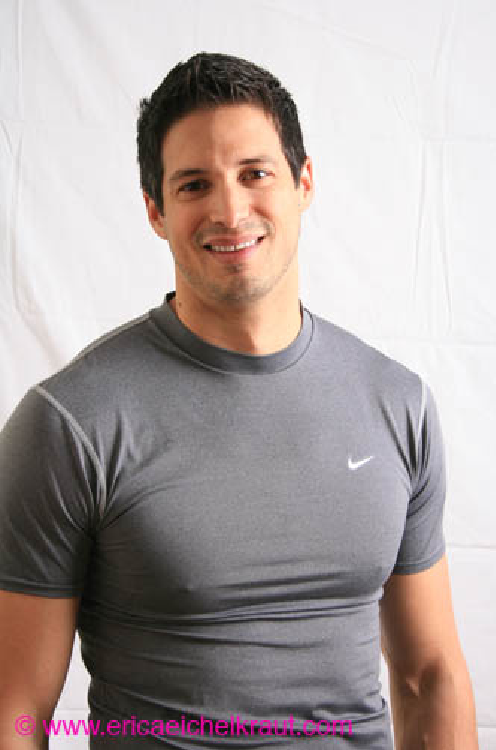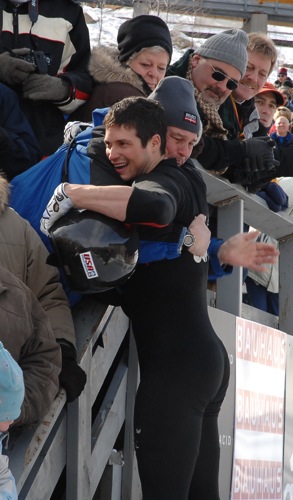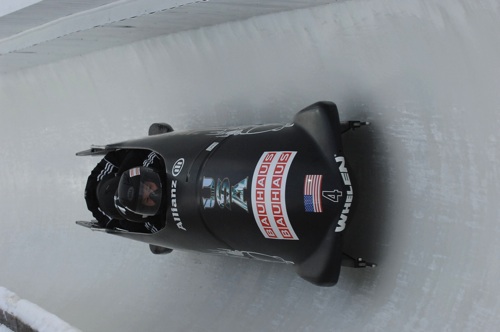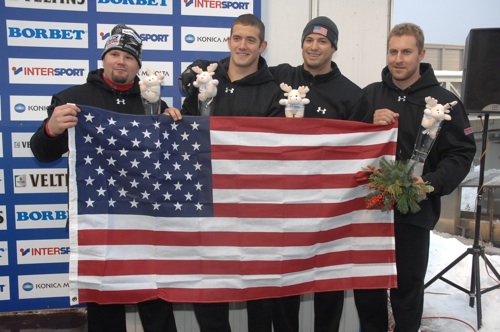In 1959, the United States won its last title in men’s bobsledding. For 50 years, they were unable to repeat that feat. Until Steve Mesler and his team came along. Time to kick history’s butt, at 90 mph.
Do you remember what happened in America in 1959?
- Pantyhose, the BIC ballpoint pen, Barbie, the microchip, and the aluminum beer can were invented.
- Maxwell House inaugurated the “Good to the last drop” ad campaign, the one billionth can of Spam was sold, and Metrecal was introduced as a weight reducing aid.
- The average American earned $91.53 a week, had an annual income of $5,016, and paid $30,000 for a house.
- At the store, milk sold for $1.01, a T-bone steak $1.09/lb, and a loaf of bread cost just $0.20, only slightly less than gas at $0.25 a gallon.
- It’s the last time the US four-man bobsled team won the World Championships.
American bobsled push-athlete Steve Mesler wasn’t even born in 1959 but he sure knows something about that year.
He doesn’t just want to win. He wants to change history.

50 years overdue
Along with his teammates Steve Holcomb (pilot), Justin Olsen (push-athlete), and Curt Tomasevicz (brakeman), Steve set the record straight: after five decades, Team USA once again took first place at the 2009 World Championships.
And even more satisfying, with a “large” margin of just under a second to spare over the four heat race. If you’re going to make your mark in the history books, it might as well be convincing.
Here’s the footage from the final, winning heat.
Now there’s no stopping Steve and his team — they’re gathering momentum like a sled down an icy track. And having won a silver medal at the pre-Olympic Test World Cup Event at the new Olympic Track in Whistler, BC, the two-time Olympian hopes that history will repeat itself this upcoming Olympic year.

From one track to another
Steve’s eyes were first opened to the value of proper training for sport at just 12 years old, when he took up track and field. He eventually became a National High School All-American champion and scholarship Decathlete at the University of Florida.
His many years as an accomplished track and field athlete transferred well to bobsledding, and he’s used this training as a member of the USA Bobsled team for the past nine years.
Despite his natural abilities on the track, a 14th place finish at the Junior Olympic Nationals was the impetus for Steve to pay attention to training. After spending a cold Buffalo winter doing box jumps in his parents’ garage and running the track, he went on to medal in two events the following summer.
Switching to bobsled many years later was a natural transition. As a push-athlete, training for bobsled is a cross between training like a football player and a 100 m sprinter.
These athletes need to be very fast but also need some weight and strength as well. All the training is geared for power and speed, and includes elements such as sprints, cleans, hurdle hops, and squats.
Don’t tell Coach Stuart McMillan but compared to training for the decathlon, says Steve,”bobsled training is glorious!”
Training for speed
During the competitive season for the bobsledders, training load is fairly low. 3 to 4 days are spent in the gym, with 3 days on the sliding track.
The G-forces that the athletes experience as they blister down a mile’s worth of ice and 15-foot curves at 90 mph is quite taxing. Refueling and recovering from that with a full training regimen just isn’t feasible.
With the 2010 Olympic season on the way, training is ramping up once again. USA 1’s Team Holcomb will be going with 2-a-day workouts Monday and Fridays, with single training session days 4 other days a week.
The US team is part of an international training group named 8pac. American and Canadian athletes, including world champions, Olympian medalists and competitors, as well as up-and-comers, train together under accomplished strength and conditioning coach Stuart McMillan in Calgary, AB.
They’re a hungry group, and their drive and work ethic continues to both inspire and amaze Steve.

From Taco Bell to the JB plan of eating
Despite an early lesson in the value of training, it was a few more years before Steve would understand that pre-workout meals of Taco Bell were not going to get him ahead on any track.
During his first year at the University of Florida, Steve made huge strides in his performance. Coach Jerry Clayton was big into nutrition and taught Steve the basics of the trade.
Since then, Steve has based his entire training regime around his diet. After meeting John Berardi in 2003, he now follows what he calls the “JB plan of eating”: all meals contain a healthy chunk of protein with carbs during and after workouts, and good fats at all the other meals.
Not only does his nutrition plan keep him healthy and recovered for optimal performance, but it also keeps him disciplined. The structure of a good nutrition plan helps every other aspect of his training fall into place.
Most days look something like this:
- 8:30 am breakfast: 4-5 eggs/egg whites, 2 portions of dry curd cottage cheese, some fruit and green tea
- During/post -training: JB shake: 40 g protein with 90 g Gatorade in 800 mL water with creatine and beta alanine mixed in
- 2-3 pm post training lunch: meat protein (chicken, ground beef, steak, fish) with couscous or multi-grain bread, large spinach salad with mixed beans, walnuts, fruit in a sesame ginger dressing
- 5:00 pm: a small snack
- 7-8 pm dinner: similar to lunch without the added starchy carbs, unless he feels depleted from training
- 10 pm snack: dry curd cottage cheese and fruit along with a shake (whey and lactose-free milk)
Workout supplements have an important place for Steve and his Olympic goals. Indeed, he’s currently looking for a new supplement sponsor after dropping his last one due to changes in production practices.
But his advice to young athletes? Instead of focusing on the supplements, try to find all of the nutrition you can from food.
“I believe the body processes the food humans have been eating for thousands of years so much better than the things we have learned to manufacture in the past few decades. Eat, eat and eat! And if you reach a training or weight gain plateau that you can’t meet with food, then start to think about supplements.”
Dry curd cottage cheese = a boblsledders superfood?
Uumm… dry curd cottage cheese?
In case you missed it, Steve’s a big fan of it. He knows it’s not the most popular food out there (as evidenced by how hard it is to find!) but it’s something he’s learned to love.
At 22 g of protein per serving, minimal fat and sodium, lactose-free, it’s been a great way for Steve to get in high amount of protein to support his training and performance.
Steve has always met much of his protein needs with dairy products – he’s had at least a couple glasses of milk each day for as long as he can remember.
But in the past few years, strange symptoms started to appear. For instance, he suffered from congestion that was not cleared up with medication.
Steve and his coach began to experiment with changes in his diet. The first thing they changed: cutting out dairy products, specifically those containing lactose.
Weeks later with a clear head and throat, the solution was obvious but it created a new problem: where would Steve get the extra 80 g of protein a day?
He substituted dry curd cottage cheese for normal cottage cheese, lactose free or goat’s milk in place of skim milk, and goat cheese instead of any kind of dairy cheese. The transition wasn’t easy and it took some time to acquire a taste for the new foods but the effort has been worth it. He loves all these foods now and feels so much better in training and day-to-day.
Mind games
Steve’s college track coach, Mike Holloway, used to say: “If you’re scared, say you’re scared!”
Bobsledding has taught Steve what Mike meant. Though Steve didn’t really make the connection back then, he does now, and he applies it to everything he does.
“Whether in life or sport, if you are afraid of something, it’s OK to admit it. But you still have to get it done. If you are nervous, it’s OK to let into your mind that you are nervous, but the job that is making you that way still has to be done. So once you realize your fears, just move on to what you need to do.
Bobsledding can be a scary, nerve-racking experience. The Olympic Games can be intimidating and daunting.
But in my sport, no matter what I do or say, the race will be at 5 pm. I can be scared, nervous, [or] angry, but I will still be on the line at 5 pm and nothing will change that.
Sport and business are the ultimate situations for that. No matter how we justify to ourselves our inadequacies or doubts, we know the job we need to do. And the competitors and the survivors of this world find the way to go through with it.”
Steve’s also come to see the darker side of sports and what’s emerging in the American consciousness.
“The extent to which people are willing to go to win has risen to new heights. The doping offenses and cheating that has been going on has been a real shocker. I have also seen people do and say things that I never thought would be relevant to sport in order to try to get ahead.
With this, the Olympic movement has really been tarnished over the past few years and I hope that I can help bring it back to light over the next year as we head into the Olympics. The Olympic Games have always been put on a pedestal by society, and the actions of athletes over the past while has begun to lower that platform on which we sit.
I think the Olympic Games can still teach lessons of overcoming adversity and fair play and I hope that I can champion those things and try to begin to overshadow the problems which Olympic sport has been facing.”
After breaking a 50 year slump and rewriting history, Steve’s proud of what his team accomplished this past year.
Though there will be many scary moments and challenges to overcome at the 2010 games in Vancouver, he’s ready to tackle those curves and G-forces full speed ahead.

Learn more
Want to get in the best shape of your life, and stay that way for good? Check out the following 5-day body transformation courses.
The best part? They're totally free.
To check out the free courses, just click one of the links below.



Share